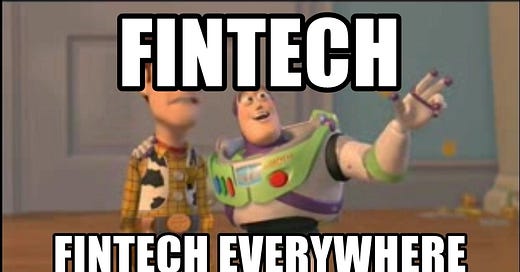Financial health and freedom are among the core tenets of our lives. They matter not just for the wellness of individuals but also of institutions and society. Money is a strange thing. It is easy for people to get weird or political or overwhelmed about talking, thinking and writing about it. Figuring out how to constantly improve financial dimension of everything and everyone around us is a worthwhile pursuit.
Fintech has become a meme. Especially in 2020. It is important to take a step back and reinforce why some of us care about that meme so much. Getting paid for the work you do matters. Making payments matters. Sending money anytime & anywhere matters. Building wealth matters. Saving and investing matters. Managing finances and planning for the future matters. Having banking products matters. Having access to credit matters. Being able to buy and sell all sorts of assets matters. Being able to buy whatever you want whenever you want matters. Getting insured matters. Having the capital to start, grow, maintain ventures matters. Being able to share money and finances with others matters. Being able to use information locked up in systems to provide better & more financial services matters. Home ownership matters.
All of this matters for individuals just as much as for businesses. There is absolutely no reason why hundreds of millions of people should suffer through the burden of not being able to do a combination of the above.
If technology can help make even incremental improvements across price, speed, usability, access, quality, transparency, personalization and reliability in any of the above mentioned categories, it is a worthwhile pursuit. An incremental improvement can make the huge difference at scale.
Throughout the 90s, 2000s and early 2010s, fintech has been a vertical. It is a collection of companies that use software to reimagine financial services and expand access to broader audiences. This includes everything from PayPal, Ant Financial, Monzo, Paytm, Klarna, Adyen, Transferwise, Paystack, Trade Republic, Tink, Wealthsimple, NuBank to Square, Affirm, Stripe, Venmo, Lending Club, Kabbage, Coinbase, Chime, Wealthfront, Robinhood.
What all of these players have in common is they are started out as financial services firms from day one. Even today, there are countless such players taking off all over the world. There is still so much room for innovation across problems ranging from how to broaden access to wealth accumulation to how to change the underlying plumbing of how money moves domestically & internationally. Unlike pure software plays like social or enterprise software, financial services are not global from day one and are beholden to domestic regulations. That reduces winner-take-all dynamics and creates room for lots of companies going after the same problems over similar timelines across regions. This is expected to continue and we are nowhere close to being done even in seemingly saturated categories.
Furthermore, in the past 5 years, a series of successes and failures captured the imagination of a generation of builders and investors in fintech in the possibility of traditional software companies launching financial services for their customers. Square launched Capital in 2014. Shopify launched Capital in 2016. Lyft & Uber launched banking products in 2019. Flexport, Stripe and Toast launched Capital in 2019. Patreon, Gusto, Stem, Doordash launched advances and banking products in 2020. Goldman Sachs has partnered with Stripe on banking as a service, Apple on credit cards and Amazon on working capital loans. Google is getting aggressive with consumer finance products.
These high profile launches by mature and beloved companies popularized the idea of what is now called embedded fintech. The very definition of fintech has started evolving. It is no longer just a vertical and can be thought of as a horizontal layer across traditional software categories. This expanded the scope of fintech radically. Now, companies that didn’t start out as fintech companies can have fintech components.
We have seen over the past two decades how impactful it is when something that’s a vertical becomes a horizontal layer. We saw this with software and cloud broadly and are now seeing it with fintech. If history is any guide, we are on the cusp of an explosion of financial services innovation across markets, regions, companies, demographics.
An imperfect but illustrative analogy is internet native creators and influencers launching everything from cosmetics and apparel to podcasts and restaurants! Hotels, retail brands and airlines have long worked with financial institutions to have special credit cards and reward programs. Now, an entire generation of companies are cropping up to put that trend on steroids, widen the scope of what financial products can be launched and include software companies in this movement! On the flip side, an entire generation of software companies is now looking to launch financial services! More and more banks are looking to partner with the infrastructure companies to stay relevant and find new revenue streams. There’s also a generation of lawyers, accountants and finance people getting up to speed on helping software companies launch products as quickly as possible.
All of this matters not because its is good story that can fetch high valuation multiples and press coverage. It matters because we are using technology to improve across a combination of price, speed, access, quality, usability, transparency, personalization and reliability of financial services.
This is why some of us care about fintech. No matter how cringey we get, all of us want to play a role in improving financial health of people.



Great read!
Spot on.